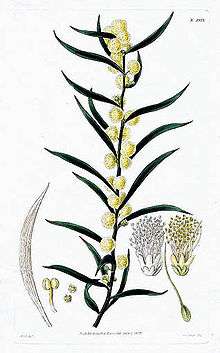Acacia lanigera
| Acacia lanigera | |
|---|---|
 | |
| Acacia lanigera illustrated in The Botanical Magazine in 1829. | |
| Scientific classification | |
| Kingdom: | Plantae |
| (unranked): | Angiosperms |
| (unranked): | Eudicots |
| (unranked): | Rosids |
| Order: | Fabales |
| Family: | Fabaceae |
| Genus: | Acacia |
| Species: | A. lanigera |
| Binomial name | |
| Acacia lanigera A.Cunn.[1] | |
| Synonyms | |
| |
Acacia lanigera, commonly known as woolly wattle or hairy wattle, is a tree species that is endemic Australia. It has an erect or spreading habit, growing up to 2 metres high, The phyllodes, which may be hairy or glabrous, are up to 20–70 mm in length and 2–8 mm wide. The bright yellow globular flowerheads appear in the leaf axils from May to October, followed by curved or coiled seedpods that are densely covered with white hairs and are up to 10 cm long.[2]
The species occurs in New South Wales, Victoria and the Australian Capital Territory.[1] It was first formally described by botanist Allan Cunningham in Geographical Memoirs on New South Wales in 1825.[1] He described it as "a shrub frequent on rocky barren ranges in the interior".[1]
Three varieties are currently recognised:
- Acacia lanigera var. gracilipes Benth., occurring in the Wallagaraugh River area in south-eastern New South Wales and Victoria.[2]
- Acacia lanigera A.Cunn. var. lanigera
- Acacia lanigera var. whanii (F.Muell. ex Benth.) Pescott, a variety first collected from Skipton, Victoria by William Taylor Whan.[1]
The variety venusola is currently regarded as a species in its own right - Acacia venulosa.[1]
Cultivation
The species prefers a well-drained sunny situation and will tolerate frosts down to -7 Celsius. It is adaptable to use in situations where maintenance is infrequent such as road batters.[1]
References
- 1 2 3 4 5 6 7 "Acacia lanigera". Australian Plant Name Index (APNI), IBIS database. Centre for Plant Biodiversity Research, Australian Government, Canberra. Retrieved 2010-08-10.
- 1 2 "Acacia lanigera". PlantNET - New South Wales Flora Online. Royal Botanic Gardens & Domain Trust, Sydney Australia. Retrieved 2010-08-10.